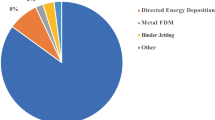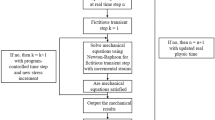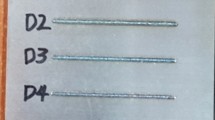Abstract
Directed energy deposition (DED) is an additive manufacturing (AM) process where a laser is used to fuse a metal powder onto a substrate. The powder is deposited in a layer-by-layer fashion, and each deposited track is referred to as the clad. Large thermal gradients that occur during DED can cause changes in the clad geometry as well as deformation of the substrate and final part. Thermal behavior of DED manufactured parts and mitigation of thermal distortion has been addressed in the literature, but these studies mainly focused on material properties while neglecting the effect of thermal distortion on part geometry. One of the mitigation strategies that has been widely tested and accepted is substrate preheating. This study uses analytical and experimental models to observe changes in clad geometry when energy input to the part is varied by adjusting process parameters and preheating the substrate. A method to quantify substrate energy, or the amount of heat energy the substrate holds, is found as well as a relationship between the substrate energy and clad geometry. The geometry of the clad can be controlled by controlling the total energy added to the clad.
























Similar content being viewed by others
References
Prakash KS, Nancharaih T, Rao VS (2018) Additive manufacturing techniques in manufacturing - an overview. Mater Today Proc 5(2):3873–3882
Thompson SM, Bian L, Shamsaeii N, Yadollahi A (2015) An overview of direct laser deposition for additive manufacturing; part I: transport phenomena, modeling and diagnostics. Addit Manuf 8:36–62
Foteinopoulos P, Papacharalampopoulos A, Stavropoulos P (2018) On thermal modeling of additive manufacturing processes. CIRP J Manuf Sci Technol 20:66–83
Majeed M, Khan H, Rasheed I (2019) Finite element analysis of melt pool thermal characteristics with passing laser in SLM process. Optik 194
Huang W, Zhang Y (2019) Finite element simulation of thermal behavior in single-track multiple-layers thin wall without-support during selective laser melting. J Manuf Process 42:139–148
Huang Y, Yang L, Du X, Yang Y (2016) Finite element analysis of thermal behavior of metal powder during selective laser melting. Int J Therm Sci 104:146–157
Manvatkar V, De A, DebRoy T (2015) Spatial variation of melt pool geometry, peak temperature and solidification parameters during laser assisted additive manufacturing process. Mater Sci Technol 31(8):924–930
Yan Z, Liu W, Tang Z, Liu X (2018) Review on thermal analysis in laser-based additive manufacturing. Opt Laser Technol 106:427–441
Tang L, Landers RG (2010) Melt pool temperature control for laser metal deposition processes—part II: layer-to-layer temperature control. J Manuf Sci Eng 132(1)
Muller AV, Schlick G, Neu R, Anstatt C (2019) Additive manufacturing of pure tungsten by means of selective laser beam melting with substrate preheating temperatures up to 1000°C. Nucl Mater Energy 19:184–188
Zhang K, Wang S, Liu W, Long R (2014) Effects of substrate preheating on the thin-wall part built by laser metal deposition shaping. Appl Surf Sci 317:839–855
Fallah V, Alimardani M, Corbin SF, Khajepour A (2010) Impact of localized surface preheating on the microstructure and crack formation in laser direct deposition of Stellite 1 on AISI 4340 steel. Appl Surf Sci 257(5):1716–1723
(1979) High-temperature characteristics of stainless steels. In: A Designer’s handbook series. American Iron and Steel Institute, Washington DC
Mills KC (2002) Recommended values of Thermophysical properties for selected commercial alloys. Woodhead Publishing Limited, Sawston
Carter D (2017) A study on CAM based path planning for hybrid machining center with direct energy deposition. Master’s thesis, Davis, CA
Miettinen J, Louhenkilpi S (1994) Calculation of thermophysical properties of carbon and low alloyed steels for modeling of solidification processes. Metall Mater Trans B 25B:909–916
Lindgren LE (2007) Computational welding mechanics: thermomechanical and microstructural simulations. Woodhead Publishing, New York
Lia F, Park J, Tressler J, Martukanitz R (December 2017) Partitioning of laser energy during directed energy deposition. Addit Manuf 18:31–39
Heigel JC (2018) Chapter 8 - thermo-mechanical modeling of thin wall builds using powder fed directed energy deposition. In: Thermo-mechanical modeling of additive manufacturing. The Pennsylvania State University, University Park, pp 137–151
LASERTEC 65 3D Hybrid. DMG Mori, [Online]. Available: https://us.dmgmori.com/products/machines/additive-manufacturing/powder-nozzle/lasertec-65-3d-hybrid. Accessed 2019
Argon. Praxair, [Online]. Available: https://www.praxair.com/-/media/corporate/praxairus/documents/specification-sheets-and-brochures/gases/argon/argon-ar-spec-sheet-ss-p4563.pdf?la=en&rev=d86586a5926d487ea3f79476f0d84838. Accessed 2019
Material Product Data Sheet: Austenitic Stainless Steel Powder for Laser Cladding. Oerlikon Metco, [Online]. Available: https://www.oerlikon.com/ecomaXL/files/metco/oerlikon_DSMW-0017.2_AusteniticSteel_LC.pdf. Accessed 2019
Odum KS (2019) Method to reduce final part deformation using thermal control of the directed energy deposition process. PhD dissertation, Davis, CA
Acknowledgments
The authors would like to thank DMG Mori and MTTRF for their support of the ARMS lab.
Author information
Authors and Affiliations
Corresponding author
Additional information
Publisher’s note
Springer Nature remains neutral with regard to jurisdictional claims in published maps and institutional affiliations.
Rights and permissions
About this article
Cite this article
Dill, J., Soshi, M. & Yamazaki, K. A study on the effect of directed energy deposition substrate energy on clad geometry. Int J Adv Manuf Technol 109, 315–333 (2020). https://doi.org/10.1007/s00170-020-05485-6
Received:
Accepted:
Published:
Issue Date:
DOI: https://doi.org/10.1007/s00170-020-05485-6




